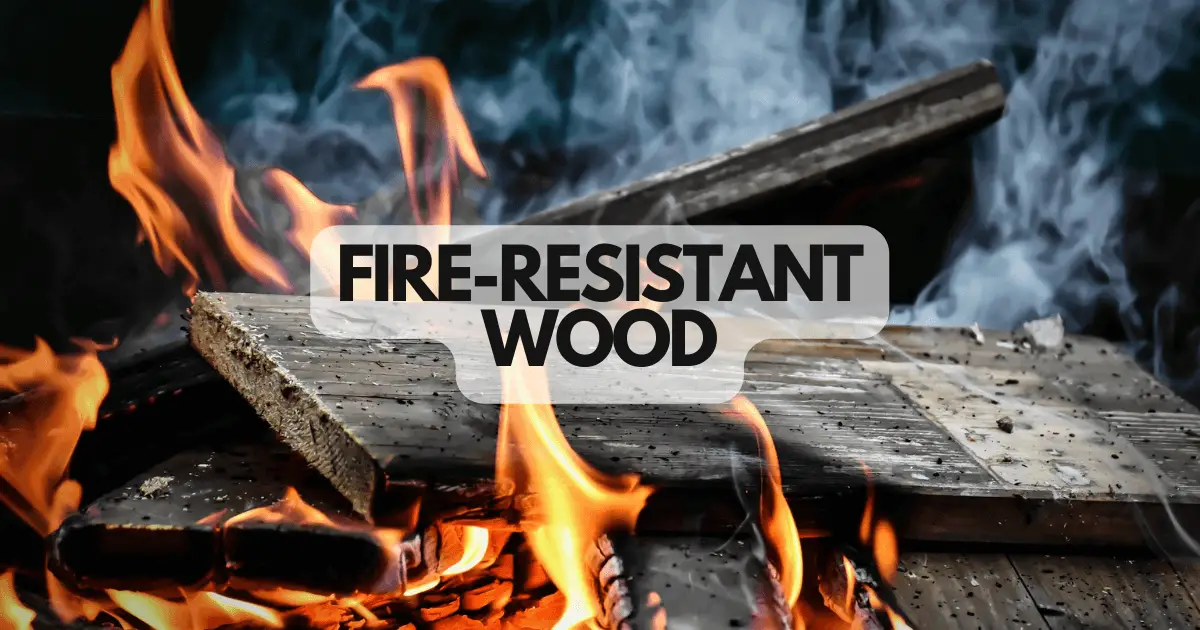Fire-resistant wood refers to wood that has basic or advanced fire-resistant properties. Fire-resistant wood prevents the spread of fire and keeps it safe. It wood is more expensive than ordinary wood, and sometimes it can be rare.
It requires less maintenance and care than ordinary wood. Fire-resistant woods are stable, durable, and a strong choice for building and construction.
There are two types of fire-resistant wood: natural fire-resistant wood, which does not require any special treatment, and second, chemically treated wood to make it fire-resistant. In this blog post, I will share some naturally fire-resistant wood species.
Ipe Wood
Ipe wood is naturally resistant to decay, insects, and fire. It is highly durable and more stable than other hardwoods. Ipe wood is native to Central and South America.
Ipe wood is one of the most popular outdoor construction and furniture choices. Wood color can range from pale olive brown to dark brown.
Ipe Pros and Cons
Pros
- Low maintenance: Ipe wood is a strong and stable wood that requires low maintenance.
- Temperature resistant: Ipe wood is good temperature-resistant wood that maintains the house’s temperature.
Cons
- Expensive: Ipe is more expensive than other woods because of its high demand and slow growth rate.
- Hard to work: The density of Ipe wood is very high, so it isn’t easy to work with it.
Redwood
Redwood is a durable and stable hardwood. It is popular because it is resistant to insects, rot, and fire. It is native to the coastal northwestern United States.
There are three types of redwood: Dawn redwood, Giant sequoia, and Coast redwood.
Redwood Pros and Cons
Pros
- Easy to work: Redwood is easy to work with hand and machine tools.
- Appearance: Redwood has light pinkish brown to dark reddish brown color and has a straight grain. After finishing, it gives excellent results.
Cons
- Expensive: Redwood is more expensive than other woods because it is found in a limited area.
- Highly prone to dents: Since redwood is a low-density wood, its tensile strength value is 450 lbf (2,000N). So it is highly prone to dents and scratches.
Cumaru
Cumaru wood is native to Northern South America. It is also known as Brazilian Teak. Cumaru hardwood is very hard, durable, and resistant to fire. It is widely used for decking, flooring, siding, and furniture.
Cumaru Pros and Cons
Pros
- Versatile: Cumaru wood is a versatile wood species that can be used for indoor and outdoor purposes.
- Moisture-resistant: Cumaru wood can withstand extreme weather and moisture over a long time.
Cons
- Hard to work: Cumaru wood is difficult to work with because it is very hard, and the grain is interlocked/irregular.
- Change color over time: Although the color of Cumaru wood is medium brown, due to exposure to external elements, it becomes dark brown.
Ironwood
Ironwood is extremely hard, durable, and valuable hardwood. It is very resistant to decay and termites. Ironwood is known as Leadwood and is native to Southern Florida and Central America.
There are mainly two types of ironwood: Desert Ironwood and Black Ironwood. Each wood species has its unique characteristics.
Ironwood Pros and Cons
Pros
- Moisture Resistant: Ironwood is a durable wood that does not absorb moisture.
- Scratch-proof: Ironwood is significantly less prone to dents and scratches.
Cons
- Difficult to work: Ironwood is not easy to work with for a beginner. Because it is stiff (the Janka stiffness value is 3,660 lbf (16,280 N)).
- Rare and Expensive: Ironwood is rare and expensive because of its high demand and slow growth rate.
Meranti Wood
Meranti wood is moderately durable and strong and has an attractive appearance. Wood is popular for furniture, cabinetry, flooring, doors, and window frames. Meranti is native to Southeast Asia.
There are many types of meranti wood, such as dark red meranti, light red meranti, etc.
Meranti Pros and Cons
Pros
- Easy to work: Meranti wood is easy to work with hand and machine tools because it has medium density and a straight grain pattern.
- Appearance: Meranti wood has a dark reddish to purplish brown color, which looks attractive.
Cons
- Susceptible to insect attack: Meranti wood requires a lot of care and exterior finish if you use it outside.
- Expensive: Meranti wood is more costly than many other hardwoods.

